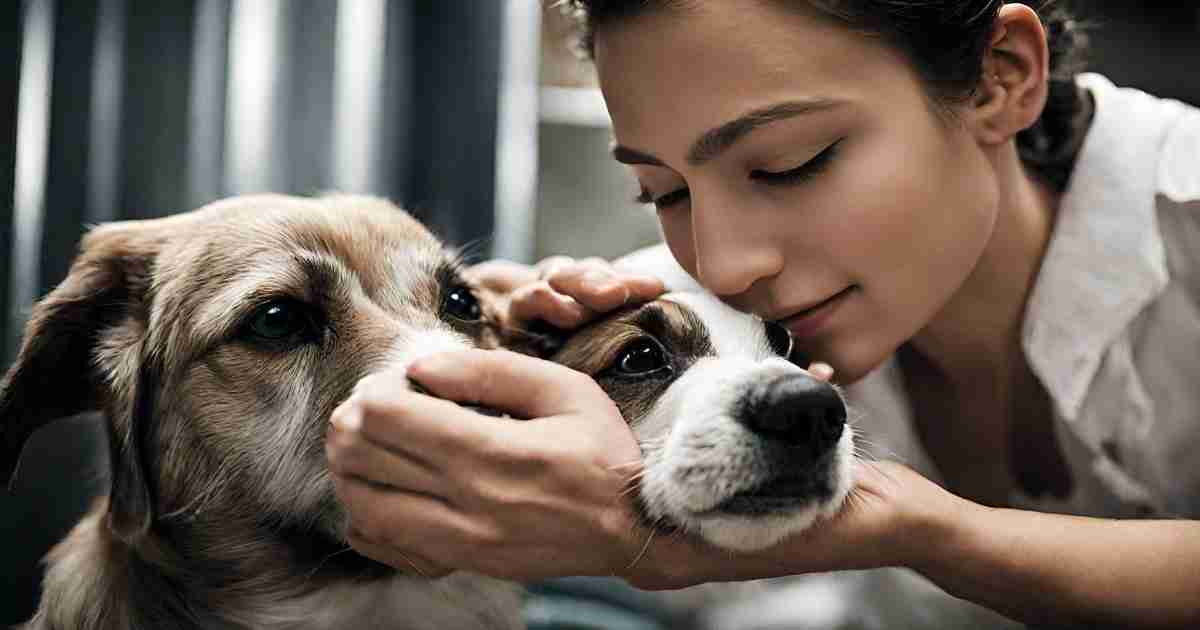Rottweiler Ear Infection is a common problem for the breed. The trademark triangular Rottweiler ears trap moisture and debris, making ear infections a frequent issue.
Left untreated, these painful infections can become chronic or lead to serious complications.
But many effective remedies are available if you know where to look. This article will explore surprising home treatments, when to see the vet, medications and procedures, plus tips to prevent ear infections in your Rottie.
With a little diligence and TLC, you can keep your pup’s ears happy and healthy for years to come. Read on to give those droopy ears some extra love!
Battling Rottweiler Ear Infections:
Let me start by saying those adorable floppy Rottweiler ears come at a cost.
As a canine health professional, I’ve seen firsthand how the breed’s trademark triangular ears readily trap moisture and debris, making ear infections a frustratingly common problem.
Left ignored, these painful infections can morph into chronic issues or spur other complications.
But in my practice, I’ve discovered an array of remedies—from simple home treatments to medications—that offer relief.
I’ll share my insights on managing Rottweiler ear infections. You’ll learn surprising at-home fixes, when to call the vet, medications and procedures that work, plus my top tips to fend off future ear trouble in your pup.
With some TLC and vigilance, you can keep those cute droopy ears healthy for years. Let’s dig in!
Anatomy of a Rottweiler Ear
I always tell clients, you’ve got to understand the anatomy to grasp why ears are such an Achilles heel for Rotties.
It comes down to two things: their floppy triangular shape and the right-angled structure of their ear canals.
Those long droopy flaps readily snag moisture, dirt, and debris. Meanwhile, vertical and horizontal ear canals meet at a 90 degree angle, making drainage poor.
The canals just aren’t constructed in a way that lets gunk easily flow out. Toss in profuse ear hair and wax production common in the breed, and you’ve got the perfect setup for infection.
- Floppy, triangular shape traps moisture and debris
- Vertical and horizontal ear canals meet at right angles
- Hair and wax also contribute to buildup
What Typically Triggers Infection
In my practice, I’ve pinpointed a handful of common culprits behind Rottweiler ear issues:
- Allergies – Food or environmental allergies can cause inflammation and itching. As dogs scratch, the irritated skin becomes prone to infection.
- Foreign objects – Those lovely floppy ears can unfortunately snag sticks, grass seeds, dirt, and other debris. These foreign objects get lodged down in the ear canal, leading to infection.
- Moisture – Swimming, bathing, even moisture from heavy panting can trap water down in the ear canal, creating the damp conditions infections feed on.
- Yeast – Humid ears are a breeding ground for yeast. Once overgrowth occurs, infection follows.
- Bacteria – Bacterial organisms like staph are opportunistic invaders, setting up shop in ears already irritated or inflamed.
- Mites – Ear mites are tiny parasites that burrow into the ear canal, causing intense itching, inflammation, and discharge.
Signs Your Rottie’s Ears Are Infected
As a canine health professional, I tell all my Rottweiler clients to watch for these common signs of ear trouble:
- Head shaking or tilting – They’ll twitch or shake their head or even tilt it to one side. The asymmetry means only one ear is affected.
- Scratching or rubbing – Watch for them pawing at their ears or rubbing against furniture. This is a dead giveaway for discomfort.
- Redness or swelling – The earflaps or canal will look red, inflamed and swollen.
- Odor and discharge – Infection causes a rancid smell and brown, waxy buildup. You may see blackish discharge.
- Pain – They’ll yelp or pull away if you touch the infected ear.
Don’t let things progress to this painful stage! At the first hint of trouble, try these home fixes:
Surprising Home Remedies
Over the years, I’ve discovered several home treatments that work wonders on mild Rottweiler ear infections if you catch them early…
Anatomy of a Rottweiler Ear
As a canine health professional, I’ve spent countless hours peering into Rottweiler ears, and let me tell you—their anatomy spells trouble.
Those trademark floppy, triangular ear flaps are prone to trapping moisture, dirt, grass seeds, you name it. All kinds of gunk gets stuck in the nooks and crannies of those long droopy pinnae.
But the real issue lies deeper, down in the ear canal itself. You see, vertical and horizontal ear canals intersect at almost a 90 degree angle.
That right-angled junction doesn’t allow proper drainage. Anything that gets pushed down into the canals through the ear flaps just gets stuck. There’s no easy way out.
I often marvel at how ingeniously designed our canine companions are…but this ear structure is one flaw in the Rottweiler blueprint. It’s a drainage nightmare!
Add in the prolific ear hair Rotties are blessed with, plus heavy ear wax production, and you’ve got the perfect storm. All that hair and wax further block up the already poor drainage.
Before long, debris accumulates. Moisture gets trapped. And voila, we have the ideal environment for infection to brew.
It’s no wonder ear issues are so ubiquitous in the breed. With their anatomy, infections are inevitable without diligent prevention. But armed with that insight, we can get a step ahead.
Knowing what predisposes Rotties helps us form a game plan to keep their ears infection-free. Let’s look closer at the most common causes next.
Common Causes of Infection
As a canine health care professional, I’ve seen time and again how prone Rottweilers can be to ear infections.
Their floppy ears, allergic tendencies, and love of water make the breed a perfect candidate for recurring ear issues.
In this section, I want to break down the most common causes of Rottweiler ear infections so owners can be informed and proactive.
Allergies
Just like humans, dogs can develop environmental or food allergies that cause inflammation and itching.
Rottweiler often rub and scratch their irritated ears, causing trauma that allows infection to take hold.
Controlling allergies through diet trials, medications, or immunotherapy is crucial.
Foreign Objects
It’s not uncommon for grass seeds, dirt, or other debris to get lodged down in a Rottweiler’s ear canal, especially if they love to dig and explore outdoors.
These foreign objects can cause significant irritation and infection in the delicate ear canal. Regularly checking and gently cleaning ears helps prevent this.
Moisture Buildup
While Rottweiler love swimming and bathing, excess moisture in the ears from these activities can allow yeast and bacteria to thrive.
Folding and thoroughly drying droopy ears after water exposure minimizes this risk.
Yeast
The yeast Malassezia lives naturally in canine ears but can overgrow leading to infection.
Allergies, moisture, and trauma allow overgrowth of this opportunistic yeast. Anti-fungal cleansers and medications treat yeast-based ear issues.
Bacteria
Bacteria like Staphylococcus, Pseudomonas, and Proteus can infect the ear canal, especially if the ear’s natural barriers have been disrupted by allergies, trauma, or excess moisture.
Bacterial infections require prescription oral or topical antibiotics from a vet.
Ear Mites
Though less common in dogs than cats, the parasitic Otodectes cynotis mite can still infest ears and cause very irritated, itchy infections. Veterinary antiparasitics are needed to eradicate these pesky culprits.
The takeaway is that while Rottweiler ear infections have diverse causes, diligent prevention and early treatment are key to minimizing chronic or severe infections down the road.
As a accountable Rottweiler proprietor myself, I understand staying on pinnacle of ear fitness is massively vital for their remedy and wellbeing.
Please let me be aware of if you want any clarification or have extra questions!
Signs of an Ear Infection
As a canine health expert, I want to empower Rottweiler owners to recognize the signs of a potential ear infection in their dogs.
Catching ear issues early is crucial to minimize discomfort and prevent the infection from worsening. Here are the most common symptoms:
- Head Shaking or Tilting– Dogs will violently shake their heads or tilt them to one side trying to relieve irritated ear discomfort. The ear flap may make a flapping sound with head shakes.
- Scratching or Rubbing Ears– Repeated scratching at the ears with rear paws or rubbing ears along the floor or furniture is a clear sign of ear irritation and potential infection.
- Redness or Swelling– The ear flap or canal will often become red, inflamed, and swollen with infection. The ear may feel hot to the touch.
- Bad Odor and Discharge– There is often a foul, yeasty smell with debris, discharge, or wax that differs from the normal clean ear scent. Crusty buildup is common.
- Pain or Discomfort– Dogs may yelp or snap when the infected ear is touched. Just using a cotton ball during cleaning may cause pain.
- Changes in Behavior– Due to feeling unwell, the dog may seem more irritable, lethargic, or restless. Appetite changes can also occur.
While most dogs will show multiple symptoms, even subtle signs deserve a veterinary exam.
The sooner Rottweiler ear infections are diagnosed and treated, the better the outcome for regaining comfortable, healthy ears free of issues.
Surprising Home Remedies
Tea Tree Oil
As a canine health professional, I’m always looking for effective home remedies that can provide relief for minor Rottweiler ear infections and be used safely alongside traditional veterinary treatment.
One surprising natural option is diluted tea tree oil.
Tea tree oil contains potent antifungal and antibacterial compounds like terpinen-4-ol.
This makes it a great natural weapon against the yeasts, bacteria, and mites that cause ear infections.
It’s gentle enough for maintenance use in clean ears, but strong enough to help fight current infections.
My suggested use is mixing a few drops of tea tree oil into a carrier oil like mineral oil or olive oil.
The carrier oil dilutes the tea tree to a safe concentration for the sensitive ear canal lining.
After thoroughly cleaning the infected ear, massage a small amount of the dilution into the ear flap.
Use cotton balls to gently distribute the oil just inside the ear canal opening, taking care not to push debris further into the canal.
For maintenance, continue applying the diluted oil 2-3 times per week after bathing or swimming.
For active infections, apply 1-2 times daily at the recommendation of your vet. Monitor for any redness or irritation, and stop use if the ears seem more inflamed.
Alongside proper veterinary treatment, tea tree oil can provide extra germ-fighting power and soothing relief for Rottweiler ear infections. Just be sure to dilute properly and not over clean tender ears.
Apple Cider Vinegar
Another home remedy I often recommend for minor Rottweiler ear infections is dilute, organic apple cider vinegar.
The gently acidic pH of apple cider vinegar helps restore the normal, slightly acidic environment of the healthy ear canal. This acidic state helps prevents overgrowth of bacteria and yeast.
My suggested use is mixing equal parts raw, unfiltered apple cider vinegar and purified water.
The water dilutes the vinegar to a non-irritating acidity. After thoroughly cleaning out the infected ear canal with a veterinarian-approved cleanser, saturate a cotton ball with the diluted vinegar and squeeze a small amount into the infected ear.
Massage the ear gently to distribute the vinegar, taking care not to push any debris further into the canal.
Apply 1-2 times daily at the recommendation of your veterinarian. It’s best used in early stages of infection and alongside prescription treatments for its added antifungal and antibacterial effects.
As with any home remedy, discontinue use if redness or irritation occurs. But diluted ACV can be a helpful component of treatment for many minor to moderate Rottweiler ear infections.
The vinegar helps restore the ideal ear environment to speed healing. Monitoring the ear closely and working with your vet is crucial though.
Let me know if you have any other questions on using ACV for ear health!
In addition to tea tree oil and apple cider vinegar, I wanted to quickly summarize a few other natural options that can provide relief for minor Rottweiler ear infections when used carefully alongside veterinary treatment:
Coconut Oil
The moisturizing properties of virgin coconut oil can help soothe inflamed ear tissue. Apply just a small amount to avoid trapping debris. Discontinue use if redness worsens.
Aloe Vera
The cooling gel from an aloe leaf can reduce soreness and irritation when applied around the outer ear flap. Never insert gel in the canal.
Honey
Well-diluted honey has mild antibacterial effects to aid healing. Mix with warm water and gently flush the ear canal as directed by your vet.
Probiotics
Oral probiotics support healthy skin and may reduce allergic reactions. Vets may recommend dog-specific strains.
Diet Changes
Diets free of common allergens like chicken, beef, and wheat may help resolve underlying allergies contributing to chronic ear issues.
As you can see, many natural remedies can provide relief and be beneficial additions to the vet treatment plan.
But severe or chronic Rottweiler ear infections do require professional diagnosis, prescription medications, and monitoring.
Home options should only be used under veterinary guidance to avoid worsening the infection.
As a canine health expert, I want to provide guidance on when veterinary treatment is crucial for Rottweiler ear infections and summarize the most common medications and procedures used.
When to See the Vet
While minor ear irritations can be managed with home care, it’s important to involve your vet if:
- The infection is severe or persists more than 1-2 days without improvement
- Home remedies provide no relief of symptoms
- Fluid-filled swelling of the ear flap (hematoma) develops
- Your Rottweiler seems in significant pain or distress
Do not delay seeking veterinary care for a worsening or un-resolving infection, as permanent damage can occur.
It’s better to have your vet examine the ears and determine if prescription treatment is needed.
Medications and Treatments
Cleaning
Vets often start by thoroughly flushing the ear canal to remove debris so medication can penetrate deeply. They may extract material or perform a deep ear canal clean under sedation if needed.
Oral and Topical Antibiotics
Antibiotics treat underlying bacterial infections. Oral treats the whole body, while topical medications are applied directly in the problem ear for localized treatment.
Anti-fungal Medication
For stubborn yeast, vets may prescribe topical anti-fungal cleansers or injections like miconazole to resolve the infection.
Steroid Medications
Steroids help reduce swelling, itching, and inflammation. They help break the cycle of irritation that allows infections to persist.
Surgery
For severe chronic cases, procedures like ear canal ablation or total ear canal resection may be needed to fully resolve infection and prevent recurrence.
Please let me know if you need any clarification or have additional questions! I want owners to understand all the options to get their Rottweiler comfortable relief.
As a canine health professional, I always want to leave owners with clear, actionable advice on prevention.
Stopping an infection before it starts is the ultimate goal! Here are my top prevention tips for Rottweiler ear infections:
Prevention Tips
- Keep ears clean and dry – gently wipe outer ears weekly
- Trim hair around ear flaps to allow airflow
- Use drying agents after swimming and baths
- Avoid excessive digging behaviors that can abrade ear canals
- Never insert cotton swabs down into ear canals
- Catch and treat allergies early to reduce itching and trauma
- Use preventive ear cleansers recommended by your vet
With diligence to ear care and prompt treatment of any issues, we can greatly reduce the frequency and severity of Rottweiler ear infections.
Conclusion
While quite common, ear infections are very manageable in Rottweilers with proper veterinary care and prevention.
For mild cases, home remedies can provide relief when used carefully. But it’s crucial to involve your vet promptly if the infection persists or worsens.
Regularly removing debris and keeping ears dry is key to avoiding recurrent issues. With informed ownership and proactive care, most Rottweiler can live happily with healthy, infection-free ears.
Please let me know if you have any other questions! I’m always happy to discuss ways to optimize Rottweiler health and prevent issues like chronic ear infections.
FAQs
How much does treatment usually cost?
- Mild infections treated at home – $20-50 for remedies
- Vet visit for cleaning/meds – $100-300
- Chronic surgery cases – $1000+
How long does it take for an ear infection to clear up?
- With proper treatment, most infections resolve in 7-10 days
- May take a few weeks for chronic cases
- Home remedies should show improvement in 1-2 days
How can I prevent ear infections in the future?
- Keep ears clean and dry
- Trim hair around ears
- Use drying agents after swimming
- Avoid digging behavior
- Don’t use Q-tips inside ears
- Catch allergies early
Summary
Rottweiler ear infections have many motives however can regularly be dealt with at domestic with herbal treatments like tea tree oil, apple cider vinegar, coconut oil, aloe Vera, and honey.
For extreme or continual cases, medicines like antibiotics and antifungal, veterinarian cleaning, or surgical treatment might also be necessary.
Prevention focuses on keeping ears clean, dry, and free of excess hair and debris. With diligent care, ear infections can usually be avoided or quickly resolved.










2 thoughts on “Surprising Strategies for Rottweiler Ear Infections”